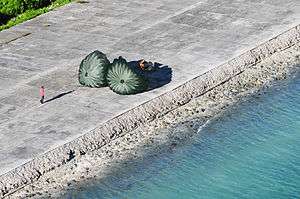Federated States of Micronesia–United States relations
Federated States of Micronesia–United States relations are bilateral relations between the Federated States of Micronesia and the United States of America.
 | |
F.S. Micronesia |
United States |
|---|---|
History

There is a U.S. Embassy in Kolonia, Pohnpei, Federated States of Micronesia with a resident Ambassador to Micronesia.
Over 25 U.S. federal agencies continue to maintain programs in the FSM. Under the Amended Compact, the U.S. has full authority and responsibility for the defense of the FSM. This security relationship can be changed or terminated by mutual agreement. Also under the Compact, Micronesians can live, work, and study in the United States without a visa. Micronesians volunteer to serve in the U.S. Armed Forces at approximately double the per capita rate as Americans. Americans can live and work freely in the FSM without the need for a visa.
The U.S. will provide about $100 million annually in assistance to the FSM over the next 20 years.[1] A Joint Economic Management Committee (JEMCO) consisting of representatives of both nations is responsible for ensuring that assistance funds are spent effectively, with the aim of fostering good governance and economic self-reliance. The basic relationship of free association continues indefinitely.
The United States is the FSM's largest trade partner.
Because of this financial relationship, the island nation has been called a haven for US military recruiters.[2][3] This arrangement has been criticized because these Island Soldiers are not entitled to the same benefits as soldiers who are US citizens; and neither they nor their families are allowed to vote.[4][5]
Principal U.S. Officials include Ambassador Robert Annan Riley III, Deputy Chief of Mission Richard K. Pruett, and Management Officer Jonathan Floss.
See also
- Foreign relations of the Federated States of Micronesia
- Island Soldier (documentary film)
External links
References
- "The Federated States of Micronesia". CIA World Factbook. U.S. Central Intelligence Agency. Retrieved 18 July 2017.
- Nobel, Justin (2009-12-31). "A Micronesian Paradise — for U.S. Military Recruiters". Time. ISSN 0040-781X. Retrieved 2018-07-14.
- "Uncle Sam wants Micronesians for US military". Christian Science Monitor. 2010-05-05. ISSN 0882-7729. Retrieved 2018-07-14.
- "Welcome". ISLAND SOLDIER. Retrieved 2018-07-14.
- "'Island Soldier': Film Review". The Hollywood Reporter. Retrieved 2018-07-14.
![]()
